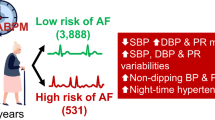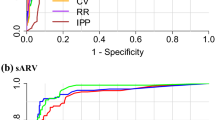Abstract
Atrial fibrillation (AF) is the most common sustained arrhythmia and is associated with an increased long-term risk of stroke. A screening test for early diagnosis has the potential to prevent AF-related strokes. This study assessed the diagnostic accuracy of an automated device for self-home blood pressure (BP) monitoring, which implements an algorithm for AF detection. A modified, automated oscillometric device for self-home BP monitoring (Microlife BPA100 Plus, Microlife, Heerbrugg, Switzerland) with an AF detector was used to carry out triplicate BP measurements in subjects with sinus rhythm, AF and non-AF arrhythmias. During each BP measurement, the electrocardiogram (ECG) was recorded simultaneously. A total of 217 simultaneous BP measurements and ECG recordings were obtained from 73 subjects. Twenty-seven subjects (37%) had AF, 23 (31%) non-AF arrhythmias and 23 (31%) had sinus rhythm. A single measurement had 93% sensitivity and 89% specificity for detecting AF. For two measurements, in which one of them was required to detect AF, the sensitivity was 100% and specificity 76%, whereas for three measurements, in which two of them were required to detect AF, the sensitivity was 100% and specificity 89% (κ=0.86 for an agreement with ECG). Using the latter approach, there were five false positive cases all having irregularities in ∼50% of the heartbeats. In patients with tachyarrhythmia, the device underestimated heart rate. These data suggest that an electronic device for self-home BP monitoring, which implements an algorithm for AF diagnosis has an excellent diagnostic accuracy and might, therefore, be used as a reliable screening test for the early diagnosis.
This is a preview of subscription content, access via your institution
Access options
Subscribe to this journal
Receive 12 digital issues and online access to articles
$119.00 per year
only $9.92 per issue
Buy this article
- Purchase on Springer Link
- Instant access to full article PDF
Prices may be subject to local taxes which are calculated during checkout
Similar content being viewed by others
References
Fuster V, Rydén LE, Cannom DS, Crijns HJ, Curtis AB, Ellenbogen KA et al. American College of Cardiology/American Heart Association Task Force on Practice Guidelines; European Society of Cardiology Committee for Practice Guidelines; European Heart Rhythm Association; Heart Rhythm Society. ACC/AHA/ESC 2006 Guidelines for the Management of Patients with Atrial Fibrillation. Circulation 2006; 114: e257–e354.
Dewar RI, Lip GY . Guidelines Development Group for the NICE clinical guideline for the management of atrial fibrillation. Identification, diagnosis and assessment of atrial fibrillation. Heart 2007; 93: 25–28.
Lip GY, Kakar P, Watson T . Atrial fibrillation—the growing epidemic. Heart 2007; 93: 542–543.
Fitzmaurice DA, Hobbs FD, Jowett S, Mant J, Murray ET, Holder R et al. Screening versus routine practice in detection of atrial fibrillation in patients aged 65 or over: cluster randomised controlled trial. BMJ 2007; 335: 383–386.
Kearney PM, Whelton M, Reynolds K, Muntner P, Whelton PK, He J . Global burden of hypertension: analysis of worldwide data. Lancet 2005; 365: 217–223.
Kannel WB . Prevalence, incidence, and hazards of hypertension in the elderly. Am Heart J 1986; 112: 1362–1363.
Parati G, Stergiou GS, Asmar R, Bilo G, de Leeuw P, Imai Y et al. ESH Working Group on Blood Pressure Monitoring. European Society of Hypertension guidelines for blood pressure monitoring at home: a summary report of the Second International Consensus Conference on Home Blood Pressure Monitoring. J Hypertens 2008; 26: 1505–1526.
Pickering TG, Miller NH, Ogedegbe G, Krakoff LR, Artinian NT, Goff D . American Heart Association; American Society of Hypertension; Preventive Cardiovascular Nurses Association. Call to action on use and reimbursement for home blood pressure monitoring: executive summary: a joint scientific statement from the American Heart Association, American Society of Hypertension, and Preventive Cardiovascular Nurses Association. Hypertension 2008; 52: 1–9.
Wiesel J, Wiesel D, Suri R, Messineo FC . The use of a modified sphygmomanometer to detect atrial fibrillation in outpatients. Pacing Clin Electrophysiol 2004; 27: 639–643.
Wiesel J, Herschman Y, Messinao FC . Detection of atrial fibrilation using a Microlife automatic blood pressure monitor (abstract). J Clin Hypertens 2008; 10 (suppl A): A84–A85.
Stergiou GS, Giovas PP, Neofytou MS, Adamopoulos DN . Validation of the Microlife BPA100 Plus device for self-home blood pressure measurement according to the International Protocol. Blood Press Monit 2006; 11: 157–160.
Mant J, Fitzmaurice DA, Hobbs FD, Jowett S, Murray ET, Holder R et al. Accuracy of diagnosing atrial fibrillation on electrocardiogram by primary care practitioners and interpretative diagnostic software: analysis of data from screening for atrial fibrillation in the elderly (SAFE) trial. BMJ 2007; 335: 380–385.
Munschauer FE, Sohocki D, Carrow SS, Priore R . A community education program on atrial fibrillation: implications of pulse self-examination on awareness and behavior. J Stroke Cerebrovasc Dis 2004; 13: 208–213.
Wiesel J, Wiesel DJ, Messineo FC . Home monitoring with a modified automatic sphygmomanometer to detect recurrent atrial fibrillation. J Stroke Cerebrovasc Dis 2007; 16: 8–13.
Jani B, Bulpitt CJ, Rajkumar C . The accuracy of blood pressure measurement in atrial fibrillation. J Hum Hypertens 2006; 20: 543–545.
Watson T, Lip GY . Blood pressure measurement in atrial fibrillation: goodbye mercury? J Hum Hypertens 2006; 20: 638–640.
Acknowledgements
This study was funded by the Hypertension Center, Third University Department of Medicine, Athens.
Author information
Authors and Affiliations
Corresponding author
Additional information
Conflict of interest
The Hypertension Center has received grants from the manufacturer of the tested device (Microlife) for other research activities. GSS was a consultant to Microlife for the design of other blood pressure monitors. Microlife was not involved in the esign of this study.
Rights and permissions
About this article
Cite this article
Stergiou, G., Karpettas, N., Protogerou, A. et al. Diagnostic accuracy of a home blood pressure monitor to detect atrial fibrillation. J Hum Hypertens 23, 654–658 (2009). https://doi.org/10.1038/jhh.2009.5
Received:
Revised:
Accepted:
Published:
Issue Date:
DOI: https://doi.org/10.1038/jhh.2009.5
Keywords
This article is cited by
-
Atrial fibrillation detection in primary care during blood pressure measurements and using a smartphone cardiac monitor
Scientific Reports (2021)
-
Screening for atrial fibrillation during automated blood pressure measurement among patients admitted to internal medicine ward
Internal and Emergency Medicine (2021)
-
Validation of the modified Microlife blood pressure monitor in patients with paroxysmal atrial fibrillation
Clinical Research in Cardiology (2020)
-
Accuracy of automated blood pressure measurements in the presence of atrial fibrillation: systematic review and meta-analysis
Journal of Human Hypertension (2019)
-
A stakeholder co-design approach for developing a community pharmacy service to enhance screening and management of atrial fibrillation
BMC Health Services Research (2018)



